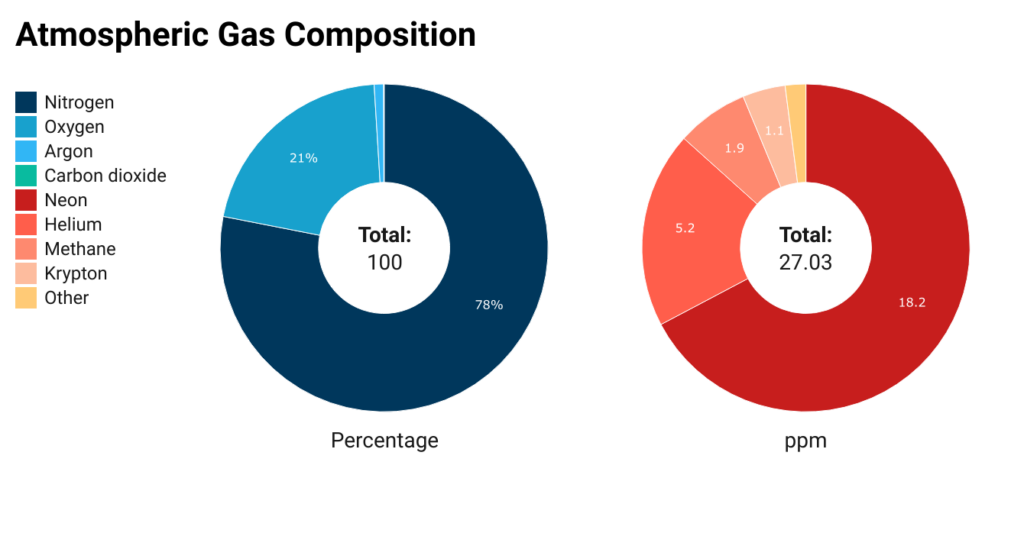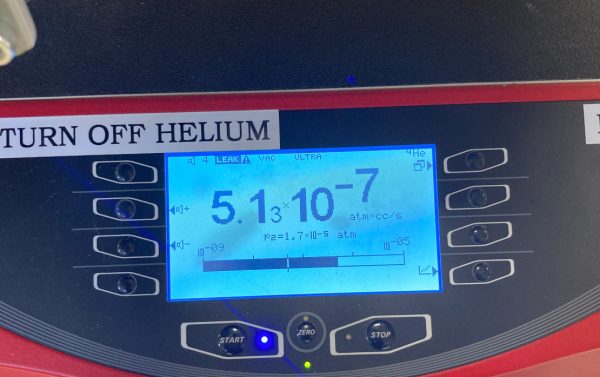What Is a Trace Gas?
A trace gas is any gas that is present in very small amounts in the atmosphere. These gases can either occur naturally in the environment or may be artificially introduced for specific purposes. Naturally occurring trace gases often signal chemical or biological processes, while artificially introduced trace gases are used in applications such as leak detection.
For example, methane, a natural trace gas, is produced by certain biological processes. On Earth, its presence in small concentrations can indicate biological activity. Interestingly, methane has also been detected in minute amounts in the atmosphere of Mars, sparking interest among researchers who are studying the possibility of microbial life or other processes occurring on the planet. On Earth, carbon monoxide—a toxic trace gas—is produced by incomplete combustion and is often detected in homes with carbon monoxide detectors to prevent dangerous exposure.
What Are Trace Gases Used For?
The use of trace gases can vary depending on their type and properties:
- Some trace gases are produced by biological or chemical reactions. For example, nitrous oxide (N2O), a gas released by soil microbes during processes like nitrification and denitrification, is present in trace amounts in the atmosphere. While it is a natural part of the nitrogen cycle, nitrous oxide also plays a role in the atmosphere due to its ability to influence ozone levels, even at small concentrations. Similarly, methane and carbon monoxide, as mentioned earlier, are produced by biological processes and chemical reactions, and their presence can signal important environmental or biological events.
- Leak Detection: Artificially introduced trace gases are commonly used in leak detection. These gases act as “tracers” and help to locate leaks in systems like pipelines and reservoirs or hermetically sealed devices such as pacemakers and airbag inflators. Helium, for example, is a common trace gas used in leak detection due to its small size, scarcity in the atmosphere, and inert properties.
Interested in learning more about leak detection? Read more on Leak Detection Basics
Examples of Trace Gases
When answering what are trace gases, it’s important to understand which gases are commonly classified as trace gases. While Earth’s atmosphere is mostly made up of nitrogen, oxygen, and argon, many other gases exist in very small concentrations, and these may be used as tracer gases. Some examples of trace gases include:
- Carbon Dioxide (CO2)
- Neon
- Helium
- Krypton
- Methane
- Mercury
These gases are typically measured in parts per million (ppm, 0.0001%) or parts per billion (ppb, 0.0000001%) due to their minuscule concentrations in the atmosphere. In the context of leak detection, gases such as helium and hydrogen are most commonly used. They are easily detectable because of their molecular weight and are uncommon in the natural environment.

Are Trace Gases Harmful?
Are trace gases harmful? It depends on the type of trace gas. Some trace gases can be hazardous, with either acute or chronic exposure:
- Toxic Trace Gases: Gases like carbon monoxide, hydrogen sulfide, and sulfur dioxide are toxic and can be dangerous even at low concentrations.
- Harmless Trace Gases: Other trace gases such as helium are completely harmless and commonly used in applications like leak detection.
Note, it is important to remember that even non-toxic trace gases, like helium, can pose a risk if they displace oxygen in confined spaces. Always handle gases with care, especially under pressure.
What Is a Tracer Gas?
You may have heard the term ‘tracer gas’. Unlike naturally occurring trace gases or those released as byproducts of manufacturing, a tracer gas is specifically introduced into a system for the purpose of leak detection. They are ideal for pinpointing the exact location of leaks in systems like pipes, tanks, or other sealed environments.
Helium is one of the most commonly used tracer gases due to its small molecular size, which allows it to seep through the tiniest of leaks. When used with a leak detector (mass spectrometer), tracer gases can help quickly identify the location of leaks, allowing technicians to pinpoint and address the issue. This makes them invaluable in industries like refrigeration, manufacturing, and aerospace.

How Is a Tracer Gas Used to Detect Leaks?
Tracer gases are used in several methods to detect leaks. These include:
- Sniffer Method: In this method, the tracer gas is introduced inside the part, and a probe connected to a leak detector is used to search for gas leaks. The detector identifies the location of the leak based on the presence of the tracer gas.
- Spray Method: The system or part being tested is evacuated and connected to the leak detector. Trace gas is sprayed around any potential leak points and any gas entering the system is quickly detected by the mass spectrometer, pinpointing the exact location of the leak.
- Hard Vacuum – Inside Out Method: The part that will be tested has some trace gas injected into it before it is sealed up. It is then placed into a vacuum chamber. The vacuum chamber is evacuated and a sample of gas from the vacuum chamber is directed to the mass spectrometer and evaluated for any trace gas that may be leaking from the test part and into the vacuum chamber.
- Hard Vacuum – Through Leak Method: Sometimes testing a component before it is added to an assembly can reduce scrap and improve product quality. The component is fixtured into a system capable of drawing vacuum on one side of the part (connected to the mass spectrometer) and introducing a trace gas on the other side of the component. Leaking components are detected and removed from the production process.
Ensure the accuracy of your leak detection system by using a reference standard with an accredited calibration.
Key Takeaways About Trace Gases
- What are trace gases? These are gases that are present in very small concentrations in the atmosphere. They can be naturally occurring or artificially introduced for various purposes.
- What is trace gas used for? Trace gases are used in a variety of applications, including indicating biological or chemical processes and detecting leaks.
- Are trace gases harmful? It depends on the specific gas. Some, like carbon monoxide, are toxic, while others, like helium, are harmless unless they are the means of displacing oxygen.
Whether used for scientific research or industrial applications, trace gases play an important role in our daily lives by making it possible for our foods and medicines to be refrigerated, by assuring us that life-supporting and safety devices always work properly when we need them, and in countless other ways that we never even think about.

